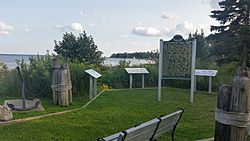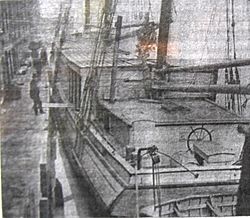Rouse Simmons facts for kids
|
Rouse Simmons tied up to dock ca. 1900
|
|
Quick facts for kids History |
|
|---|---|
| Name | Rouse Simmons |
| Builder | |
| Launched | August 15, 1868 |
| Identification | US 110087 |
| Nickname(s) | "Christmas Tree Ship" |
| Fate | Foundered and sunk on November 23, 1912 |
| General characteristics | |
| Class and type | Three mast schooner |
| Tonnage |
|
| Length | 123.5 ft (37.6 m) |
| Beam | 27.6 ft (8.4 m) |
| Height | 8.4 ft (2.6 m) |
| Propulsion | Sails |
| Crew | 5 |
| Notes | 17 persons lost in sinking |
|
Rouse Simmons (shipwreck)
|
|
| Location | Lake Michigan, 6 miles (9.7 km) off Point Beach, Wisconsin |
| MPS | Great Lakes Shipwreck Sites of Wisconsin MPS |
| NRHP reference No. | 07000197 |
| Added to NRHP | March 21, 2007 |
The Rouse Simmons was a famous sailing ship known as a three-masted schooner. It became well-known because it sank in a big storm on Lake Michigan in 1912. The ship was on its way to Chicago carrying a special cargo: Christmas trees. Sadly, it went down near Two Rivers, Wisconsin, and everyone on board was lost.
People often called it The Christmas Tree Ship. It was one of many schooners that used to carry Christmas trees across the lake. Today, the Rouse Simmons is remembered through local stories and even ghost sightings. Its final journey is sometimes traced by tourists. The way Christmas trees were shipped changed a lot over time. By the 1920s, trains and trucks became much cheaper. This meant ships like the Rouse Simmons stopped carrying trees.
Contents
The Ship's Early Life
The Rouse Simmons was built in Milwaukee, Wisconsin, in 1868. The company that built it was Allan, McClelland, & Company. The ship was named after a businessman from Kenosha named Rouse Simmons. Soon after it was built, a rich lumber owner named Charles H. Hackley bought the schooner. He lived in Muskegon, Michigan.
The Rouse Simmons joined Hackley's large group of ships. It worked hard for about 20 years. Its job was to carry lumber from Hackley's mills to different ports around Lake Michigan. At its busiest, the schooner sailed almost every week. It traveled between Grand Haven and Chicago.
After working for Hackley, the ship was sold many times. Many similar schooners were also sold often. They were sometimes called "tramp ships" because they didn't have one steady route. In 1910, Herman Schuenemann bought a part of the ship. By 1912, he owned a bigger share. Captain Charles Nelson of Chicago owned another part. He sailed with Schuenemann on the ship's last trip. A businessman named Mannes J. Bonner owned the largest share.
The Famous "Christmas Tree Ship"
The Schuenemann brothers, Herman and August, had been selling Christmas trees in Chicago for a long time. August sadly died in November 1898. His ship, the S. Thal, sank in a storm near Glencoe, Illinois. Herman, his younger brother, kept the family business going.
Many other tree sellers sold their trees to big stores. But Herman Schuenemann sold his trees directly to people in Chicago. He sold them right at the dock near Clark Street Bridge. By selling directly, he could offer trees at low prices. He still made a good profit. His business used the slogan "Christmas Tree Ship: My Prices are the Lowest." He even put electric Christmas lights and a tree on top of the ship's main mast.
The trees usually sold for between 50 cents and $1. Herman Schuenemann was kindly known as "Captain Santa." He also gave away some trees to families who needed them.
The Final Voyage
Herman Schuenemann loaded the schooner with 5,500 trees. He got them from Thompson Harbor near Manistique, Michigan. He planned a week-long trip to Chicago. Bad weather had stopped other tree sellers from making their journeys. Snow had also covered the tree farms in Michigan and Wisconsin. Schuenemann hoped that fewer trees available would mean a big profit for him. He wanted to solve his money problems.
November was known for strong storms on the Great Lakes. In 1912, November had been fairly calm at first. But a second storm was starting to brew. The weather on the day of the trip was very bad. Many ships stayed in port to be safe. They wanted to avoid the 60 mph winds that could happen in a November storm.
Some local stories say that certain sailors refused to get on the ship. They believed the ship was not safe enough to sail. Two years before, the schooner had been pulled to port. It was found riding very low in the water. Despite these warnings, the journey began at noon. Trees were packed into every possible space on the ship. The weight of the trees was much more than recommended. This was especially dangerous in the bad winter weather. The heavy load certainly helped cause the tragedy.
During the night, the storm hit the Simmons hard. Two sailors went to check the ropes holding the trees on deck. A giant wave swept both sailors overboard. It also took many bundled trees and a small boat. With less weight, the schooner became a bit easier to steer. Captain Schuenemann tried to guide it towards Bailey's Harbor. But suddenly, the storms got even worse. Ice formed on the wet trees. Strong winds battered the ship's hull.
When the Kewaunee Life Saving Station saw the Rouse Simmons on November 23, 1912, it was low in the water. Its sails were torn. It was flying its flag at half mast, which is a sign of distress. Records from the station show that a surfman saw the Simmons at 2:50 p.m. He told station keeper Nelson Craite. Craite found that the station's tugboat had left earlier. At 3:10 p.m., Craite called the nearest other station. George E. Sogge of Two Rivers sent out the power boat Tuscarora to rescue them. But the Simmons was never seen again.
The Simmons was not the only ship lost in that storm. The South Shore, the Three Sisters, and the Two Brothers also sank.
Finding the Wreckage

A message in a bottle from the Rouse Simmons washed ashore at Sheboygan. It was sealed with a small piece of pine tree. This message, along with a few trees caught in fishing nets, was all that was found of the ship for many years. The message said:
Friday … everybody goodbye. I guess we are all through. During the night the small boat washed overboard. Leaking bad. Invald and Steve lost too. God help us.
In December 1912, Christmas trees and other wreckage were reported ashore at Pentwater, Michigan.
In 1924, a fishing net pulled up a wallet belonging to Captain Schuenemann. The wallet was wrapped in oilskin, which kept it safe. It contained business cards, a newspaper clipping, and a note about expenses. In 1971, the actual ship wreck was found. A scuba diver named Gordon Kent Bellrichard from Milwaukee found it. He was looking for another ship, the Vernon. Fishermen had told him about an area where their nets often got stuck. When his sonar showed something, he dived down. He found a shipwreck 172 feet below the lake's surface. Even though his light stopped working, Bellrichard felt the wreckage with his hands. He realized he had found the Simmons.
A special study of the wreck showed that the ship could still be steered when it sank. It was likely sailing for shelter. The back mast broke off above the deck and was not found. The main mast was found near the front of the wreck. The front mast was still whole and lay on top of the main mast. This suggests at least one mast fell as the ship went down.
Many of the Christmas trees are still inside the ship's hold. Two trees were taken out and shown in exhibits. Several items found from the Rouse Simmons are now in the Rogers Street Fishing Village Museum in Two Rivers. This includes the ship's wheel. The ship's anchor was also found. It now stands at the entrance to the Milwaukee Yacht Club. The remains of the wreck are listed on the National Register of Historic Places.
The Ship's Lasting Memory
The spirit of the Christmas Tree Ship continued through Schuenemann's wife, Barbara, and their two daughters. However, in later years, they chose to bring the trees by train. They just used a boat as a place to sell them. The tradition of carrying trees by schooner stopped in 1920. Trains, highways, and tree farms became more popular. This made it easier and cheaper for everyone to buy a Christmas tree.
Images for kids
-
Michigan State Historic Site marker in Thompson Township, Michigan where the Rouse Simmons departed on its final voyage








